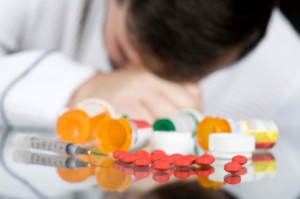Crystal Meth Addiction Treatment
Crystal meth is one of the most addictive and dangerous recreational stimulant drugs available today. The NLM states, “Crystal meth is smoked in a small glass pipe,” and smoking it can often make the drug much more addictive, as those who take it in this way will only feel the effects for a short time. They will then, often, continue to smoke it in a binge pattern in order to keep their high.
Treatment for crystal meth addiction is intensive, and different treatment types are currently being researched in order to provide more options to patients. When someone is addicted to this substance, treatment will need to be focused and immediate.
Withdrawal and Detox
Crystal meth addiction treatment usually starts with detox. According to the National Drug Strategy, “Many methamphetamine users will experience what is commonly referred to as a ‘crash’ or brief period of recovery when they stop using, which might last for a few days.” The first step of treatment is to help them through this time.
The withdrawal symptoms associated with crystal meth abuse are:
- Anxiousness
- Dysphoria (feelings strange or out of sorts)
- Depression
- Irritability
- Increased appetite
- Hypersomnia (prolonged sleep)
- Agitation
- Fatigue
- Drug cravings
These symptoms are usually at their worst for the first week or so, but some (like cravings and depression) can linger for months. Healthcare providers will help minimize a patient’s withdrawal symptoms by using therapy and medication. This will allow the patient to better receive their addiction treatment as they will not be grappling with extreme irritable or dysphoric feelings to the point where they cannot focus on treatment.
Methamphetamine-Induced Psychosis

Crystal meth addiction can cause paranoia and violent behavior.
Crystal meth may cause a condition, also referred to as stimulant-induced psychosis, that causes patients to mimic the signs of schizophrenia and suffer severe delusions as well as other behavioral issues. This often must be addressed as a part of crystal meth addiction treatment, especially when patients show signs of
- Paranoia
- Violent behavior
- Homicidal or suicidal thoughts
- Aggression
- Confusion
- Hallucinations
In this case, patients are often given neuroleptics, a common type of antipsychotic drug, to help curb these symptoms. If necessary, the patient will be restrained at first until the symptoms subside to the point where the patient is no longer dangerous. Treatment of this condition may continue into full addiction treatment, as long as the individual may need it.
Types of Facilities
In most cases, an inpatient or residential facility will be the best place for a patient to attend crystal meth addiction treatment. Because the depression caused by withdrawal poses a risk for suicide and the possibility of psychosis is common with the abuse of this drug, a patient will need to at least begin in inpatient treatment. Then, if the patient is doing well and has the potential to move on to outpatient treatment, that option can be discussed with the doctor.
Crystal meth is one of the most potent recreational substances with a high abuse rate, and those who do abuse it often feel intense cravings for the drug even years after they stop. This is another reason why inpatient treatment is often the safest choice.
Therapy
According to the NIDA, “The most effective treatments for methamphetamine addiction at this point are behavioral therapies, such as cognitive-behavioral and contingency-management interventions.” Therapy helps crystal meth addicts learn
- A new way to view their addiction itself as well as the drug causing it
- Strategies for fighting cravings
- To identify their triggers and avoid them whenever possible
- That they can change their behavior with hard work and focus
- Their addictions affect everyone around them, including friends and family members
Behavioral therapy is used to treat addiction in nearly every case as its methods can always apply to the harmful use of drugs and alcohol. Some of the most beneficial therapies used in crystal meth addiction treatment are:
- Cognitive-behavioral therapy (CBT)
- One of the most widely used treatments for addiction
- Teaches patients how to control the way they think and feel about their drug abuse
- Teaches patients how to rationalize and fight against their desire to abuse crystal meth
- Contingency management (CM)
- Often beneficial for young patients (adolescents and teens) and those who have just begun treatment
- Offers patients the ability to receive vouchers for necessities (like groceries) or fun activities (like movie tickets) as a reward for staying sober
- Uses urine testing to verify that patients have not been abusing crystal meth
- Matrix Model
- Usually lasts 16 weeks
- Combines therapy, education, drug testing, and 12-step support group attendance to help patients avoid the abuse of stimulants and learn better coping strategies
- Fosters a strong relationship between the patient and the therapist
- Group therapy
- Is used often by inpatient treatment centers in conjunction with individual counseling
- Allows patients to interact with others who have had the same experiences and struggles
- Uses the concept of resocialization which surrounds patients with other individuals who encourage their recovery and will be helpful influences to that effect
- Family therapy
- Especially beneficial for teenaged patients but can be used for patients of all ages
- Allows family members to discuss their feelings on the patient’s addiction
- Helps to heal some of the issues between patients and family members which strengthens the support system of the patient
One or more of these treatments may be used, and a patient may move into a different kind of therapy during the course of their addiction treatment. Treatment for crystal meth addiction takes time, and patients may need to undergo several therapy types before they are finished.
Co-Occurring Disorders
Often, there are other reasons why a person might begin abusing an incredibly harmful substance like crystal meth. These reasons must be addressed in treatment as well. Patients who show signs of co-occurring mental disorders such as depression, anxiety, bipolar disorder, PTSD, and other issues should be treated for them as a part of their addiction treatment. Otherwise, patients will often relapse after they leave the facility. A combination of therapy and medication may be used to treat co-occurring mental disorders.
Crystal meth addiction treatment often lasts for at least a year or longer, as the drug can cause severe damage to a person’s mind and body. If you have been abusing crystal meth and no longer feel that you can stop taking the drug on your own, it is important to seek treatment immediately.



